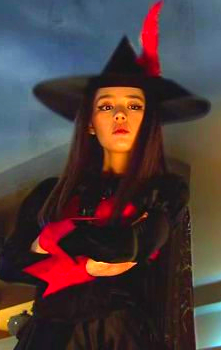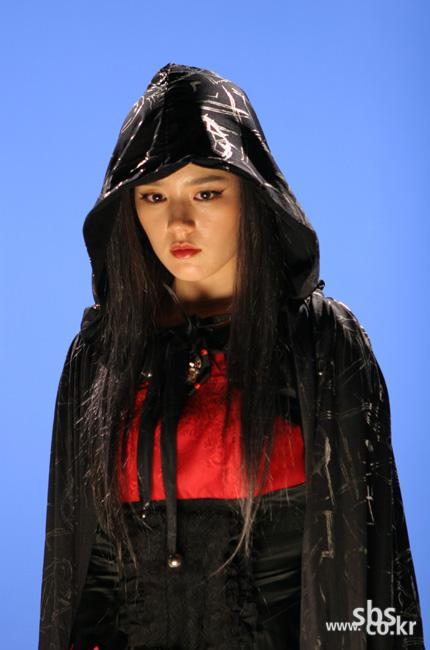 The Korean TV romantic dramedy “Witch Amusement” ran for a grand total of 16 episodes from March to May in 2007. The story centered on a young single professional woman in modern day South Korea who was derisively referred to as “manyŏ” (“witch”) behind her back by the people who worked for her.
The Korean TV romantic dramedy “Witch Amusement” ran for a grand total of 16 episodes from March to May in 2007. The story centered on a young single professional woman in modern day South Korea who was derisively referred to as “manyŏ” (“witch”) behind her back by the people who worked for her. The name of the “witch” in question is Yoo Hee, and the Korean title of the show was “Manyŏ Yoo Hee“, literally, “Witch Yoo Hee”. In Korean this is a rather clever play on words that can also mean “Witch Amusement” or “Witch In Love”.
The reason for referring to Yoo Hee as a “witch” is that she is seen as unfeminine and “cold”. She does not wear make-up and she always dresses in black clothes, and also wears glasses. She is also portrayed as pathetically unsuccessful in her attempts to have relationships with men.
 The character of Yoo Hee (played by Han Ga In) is very similar to the Witch character portrayed by Kim Novack in the 1958 “Bell Book and Candle“, and also to the journalist/activist/feminist character played by Katharine Hepburn in the 1942 “Woman of the Year“. For that matter, all three characters show striking parallels with the real life story of Queen Elizabeth I, but with one major difference, for Elizabeth never married, and reigned as one of the most powerful and successful heads of state the western world had seen since the fall of Rome.
The character of Yoo Hee (played by Han Ga In) is very similar to the Witch character portrayed by Kim Novack in the 1958 “Bell Book and Candle“, and also to the journalist/activist/feminist character played by Katharine Hepburn in the 1942 “Woman of the Year“. For that matter, all three characters show striking parallels with the real life story of Queen Elizabeth I, but with one major difference, for Elizabeth never married, and reigned as one of the most powerful and successful heads of state the western world had seen since the fall of Rome.
 In contrast to the “Virgin Queen”, however, the three fictional characters Yoo Hee, Gil Holroyd (Novack), and Tess Harding (Hepburn), all end up surrendering their “unfeminine” independence to comply with social conventions in exchange for that ultimate goal that is the true heart’s desire of all “real” women: the love of a good man. (Don’t worry, I’m not really giving very much away by telling you this….)
In contrast to the “Virgin Queen”, however, the three fictional characters Yoo Hee, Gil Holroyd (Novack), and Tess Harding (Hepburn), all end up surrendering their “unfeminine” independence to comply with social conventions in exchange for that ultimate goal that is the true heart’s desire of all “real” women: the love of a good man. (Don’t worry, I’m not really giving very much away by telling you this….)
As was the case with both “Woman of the Year”, and “Bell Book and Candle”, the lead character in “Witch Yoo Hee” is portrayed as proudly independent and highly successful. Han Ga In’s character is even a martial arts master who can (and when she feels like it, does) kick any man’s ass.
But despite (or rather, because of) her professional success and all around self-sufficiency, Yoo Hee is miserable and lonely, for, as a woman without a man, she is in an unnatural state. In fact, her greatest shame is that she has never had a second date. She has even programmed a list of “dating tips” into her phone to refer to during her unsuccessful string of blind dates (some of these dates turn out to be guys who lost a bet!):
 Try to act cute.
Try to act cute.- Have a good appetite.
- Act interested in the other person.
- Try to find things in common.
Now, as I said already, just knowing that Yoo Hee will fall in love doesn’t give very much away. It’s pretty obvious where things are headed already by the end of Episode 1, and Episode 2 quickly removes any lingering doubts. Or does it? Let’s just say there is a lot more to the story than what has been (somewhat misleadingly) revealed here.
 If you want to know more about “Witch Amusement” just check out the truly amazing website “dramabeans“, where two Korean-American women bloggers (who go by “javabeans” and “girlfirday”, and who may or may not be sisters, and/or criminals-on-the-run-hiding-from-the-law, and/or the same person,) provide detailed (and wonderfully snarktastic) commentaries on “kdramas” and other facets of “K-Pop” culture generally.
If you want to know more about “Witch Amusement” just check out the truly amazing website “dramabeans“, where two Korean-American women bloggers (who go by “javabeans” and “girlfirday”, and who may or may not be sisters, and/or criminals-on-the-run-hiding-from-the-law, and/or the same person,) provide detailed (and wonderfully snarktastic) commentaries on “kdramas” and other facets of “K-Pop” culture generally.
The cool thing, imnsho, about reading about “Witch Amusement” at the website “dramabeans” is that you have this hackneyed western cultural meme of the frustrated/liberated woman/witch being played out in a highly industrialized and in its very own and very strange way highly westernized country (and in a culture with its very own and very much alive-and-kicking ancient indigenous tradition of magical practitioners, most of whom are women), and then this all gets translated and reinterpreted for a western, English speaking audience by young Native-born Americans who happen to be young, successful professional Korean women who are obsessive fans of Korean pop culture. It is a cultural and sociological house of mirrors!
 Personally I am very curious about this Korean word translated into English as “Witch”. I poked around and found two other occurrences of the word manyŏ:
Personally I am very curious about this Korean word translated into English as “Witch”. I poked around and found two other occurrences of the word manyŏ:
사자, 마녀, 옷장 이야기 /
Saja, manyŏ, otchang iyagi /
The Lion, the Witch, and the Wardrobe (by C.S. Lewis)
포르토벨로의마녀 /
Pʻorŭtʻobello ŭi manyŏ /
The witch of Portobello /
A bruxa de Portobello (by Paul Coelho)
[NOTE: Regular readers of this blog might recognize this post from my "wordpress phase" a few months back.]






